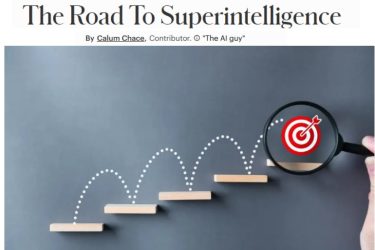Cade Metz
Cade Metz has had a dream job for the last decade. He has been hanging out with the people responsible for the most important technological developments of our time. He has had a ringside seat at what may turn out to be the pivotal episode in human history.
The book he has written about it, “Genius Makers” is based on 400 interviews conducted over eight years for “Wired” and “The New York Times”, plus another 100 carried out specifically for the book. Many of the people he has interviewed are larger-than-life characters, and given the egos involved and the prizes at stake, there is plenty of drama. If he isn’t already in negotiations with someone over the film rights, he probably should be.
Anecdotes and aphorisms
Unsurprisingly for a journalist, Metz has a breezy style that is easy and fun to read. He has collected some great anecdotes and aphorisms. If you have already been following closely the events the book describes, you might not learn much, but it will deepen your appreciation for the characters. If you haven’t been following the development of modern AI, then it will help you understand why there is so much fuss about it.
Many of the anecdotes are about Geoff Hinton, the British AI researcher who kept a flame burning for neural networks through many dark years, and Metz opens and closes his story with him. Hinton is an eccentric, clever, and complicated man: “[His response to] an email asking if he preferred to be called Geoffrey or Geoff … was equal parts clever and endearing:
‘I prefer Geoffrey.
Thanks, Geoff’”
Several times, the book describes the difficulties caused by the fact that for fifteen years, Hinton has been unable to sit down, due to a badly slipped disc. He can lie down, or he can stand. Hinton explains it with his characteristic laconic humour: “It’s been a long-standing problem”.
The last four digits of Pi
Most of the people in this book are very clever indeed, and they like to display it in their humour. Google’s senior engineer Jeff Dean is revered for his ability to wrangle large computer systems; Googlers say that the speed of light in a vacuum used to be 35mph, until Jeff Dean spent a weekend optimising physics. They quip that Dean’s PIN code is easy to hack – in theory. It is the last four digits of Pi.
The book isn’t organised this way, but Metz describes five phases in the rise of deep learning, which has brought AI to such prominent public attention. In the first phase, Marvin Minsky kills the neural net idea pioneered by Frank Rosenblatt. Minsky is something of a villain in this narrative. The second phase is Hinton’s Long March. The Chinese Communists only had to march for a year; poor Geoff Hinton had to keep his faith alive for three decades.
He was finally vindicated in the third phase, the AI Big Bang of 2012, when he and his students won the ImageNet competition for image recognition, which led to Google paying $44m for his company in a bidding war against Microsoft and Baidu. Even this was small beer compared with the $650m that Google then paid for DeepMind, a company with 50 employees and no revenues.
BERT
The fourth phase was the disappointment and disarray which set in over fake news, and bias in decision-making algorithms. This confusion was lifted slightly in the fifth phase by the arrival of BERT, which stands for bi-directional encoded transformers, a type of natural language processing AI which has produced astonishing results in translation, search, and prose composition.
It is slightly disappointing that Metz doesn’t try harder to explain how these technologies actually work. He echoes Richard Feynman’s comment that if he could explain the work that won him the Nobel Prize to a layperson, then it wouldn’t have been worth the Prize. But Feynman also said that if you can’t explain something in simple terms, then you haven’t really understood it.
Another quibble is that Metz never gives his own assessment of how far AI has really advanced. There is a fierce debate in AI circles about whether the technology has made genuine progress, or whether it is mostly hype. Some think artificial general intelligence is near, while others say that today’s systems show no sign of intelligence at all. Some of this boils down to people using different definitions of intelligence, but the answer is hugely significant. There is also resentment on the part of people who have been using the same tools for decades at being told there is a new kid on the block, just because the compute power available is vastly increased, and there is also a great deal more data. It would have been interesting to hear Metz’s thoughts on this.
Charming and moving
But the book is undeniably charming, and part of that charm is that Metz greatly likes and admires many of his characters. The elegiac final chapter featuring Hinton is genuinely moving. There are also characters about whom Metz is not so sure. Gary Marcus, the contrarian who continually denigrates the achievements of AI systems, is a “lovable narcissist”, and Metz seems none too keen on Google chairman Eric Schmidt, whom he describes as “addressing his audience as he always did—as if he knew more than anyone else in the room.” He also seems ambivalent about Facebook’s Mark Zuckerberg, who “has an almost robotic demeanour, blinking his eyes unusually often and, from time to time, making an unconscious clicking sound at the back of his throat that seems like some sort of glitch in the machine.”
The reader is left with an intriguing comparison between the world’s two most significant AI labs. Both of them have the avowed goal of creating artificial general intelligence. Both of them think this development is inevitable, and that it should be an overwhelmingly beneficial outcome for humanity. They differ about the timescale – but not by all that much, in the scheme of things. DeepMind’s CEO Demis Hassabis thinks AGI might arrive by the end of this century. OpenAI’s CEO Sam Altman thinks it will arrive much sooner, maybe within a couple of decades. If either of them is right, we should probably all be paying a lot more attention to the implications.



